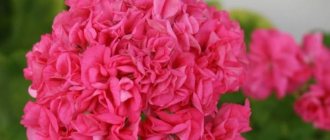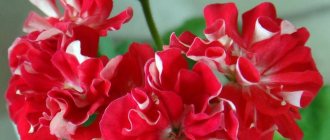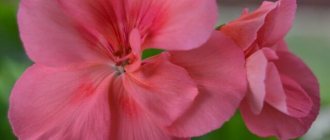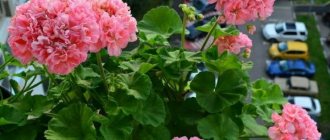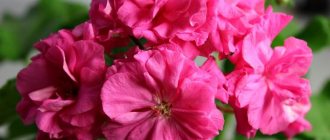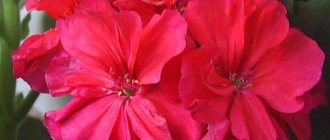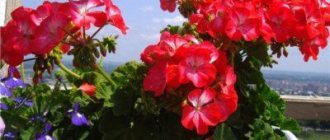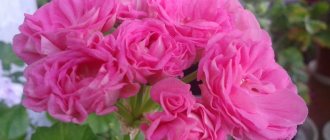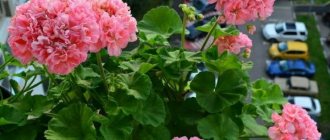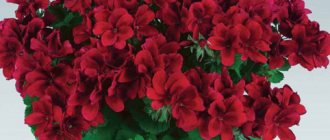Pelargonium Odensjo Symfonia - description
Pelargonium is a plant that beginning gardeners mistakenly associate with geranium. In fact, although both flowers belong to the same family, they are different in their genus, and therefore cannot be crossed. Another important point: geranium is native to the northern regions, and pelargonium is native to the southern regions. However, it is not so much the origin that is important, but the differences in the requirements regarding the maintenance and care of plants. Gardeners call one of the most beautiful representatives of pelargonium such a group of plants as pelargonium Odencio Symphony.
History of appearance and description of the variety
The beautiful Odensjo Symfonia was bred by breeders from a nursery called Rockdala, located in Sweden. The flower is characterized by the presence of tight inflorescences of a bright pink hue. The leaves are densely double, rich green.
Odensjo Symfonia - pelargonium, which is part of a large group of the same name
For your information! According to the description of pelargonium, Odensjo Symfonia lends itself well to pruning and forming a bush, is not afraid of sudden temperature changes, and is resistant to short-term cold snaps.
Other popular varieties of pelargonium from the Odensjo series
The Odensjo series also includes other varieties. They differ from each other in the color of the petals and the type of flowering. Care is almost identical.
Sound of Silence
Pelargonium Odencio Sound Silence is characterized by rather slow growth. The bushes of the plant are compact and neat. The flowers are characterized by a delicate white tone with a subtle green tint. The root system is small, and therefore the flower needs regular watering.
Symphony - pelargonium variety Sound Silence
Suzie Wong
This variety is characterized by double flowers of bright pink, deeper than the standard pelargonium Odensjo Symfonia. The plant is not capricious, it only needs a lot of diffused light and timely irrigation.
Rodluvan
The luxurious flowering of the plant cannot leave anyone indifferent. Bright red flowers appear on dense bushes.
Note! The plant does not need frequent pruning.
Bernadette
This variety is dwarf. Bernadette differs from other varieties in the surprisingly delicate pink tone of its petals.
Hummingbirds Egg Butterfly
Opened flowers delight with a rich pinkish-lilac hue. In combination with variegated leaves it looks very impressive.
Ice Frozen Campari
Flowers of a juicy lilac tone with bright spots and a contrasting core, dense green leaves - this is what makes Ice Frozen Campari a popular variety among gardeners.
Lynn Palmer
Ideal for growing indoors. The petals of the opened flowers are very decorative, they are semi-double, there is a soft gradient: from boiling white to purple and green.
Madame Bovary
This variety is loved by gardeners thanks to its bright red flowers collected in small bouquets. The variety may lose its decorative properties if it does not have enough daylight.
Stilla Flirt
Of all the varieties of the Odensio group, this is the most elegant and neat. The tone of the flowers is pale pink, standard for the group.
Varieties and their descriptions
The Odensjo Suzie Wong variety is represented by several species.
- "Symphony". Flowers of a rich pink hue, collected in inflorescences. The leaves are light green. It is unpretentious to environmental conditions, blooms well and can be molded.
- Black Mamba. It is a dwarf plant with double inflorescences of pink colors. The leaves are brown, with a thin greenish border.
- Bernadette. It is a dwarf plant with double white and pink inflorescences. In sunlight they become brighter. In spring it blooms the fastest.
- Rodluvan. Compact bushes with double flowers of a bright red hue, well formed. The inflorescences of "Rodluvan", compared to other species, are much larger.
- Ice Frozen Campari. It is a semi-double pelargonium. The inflorescences are white with red and pink splashes, the leaves are yellow. The bushes are quite miniature and fluffy.
- Made in Sweden. Presented as bushes with dark leaves. The flowers are small and resemble carnations in appearance.
- Ljus Och Varme. Refers to terry pelargoniums. The inflorescences are pinkish-white caps. But these two shades do not mix.
- Stilla Flirt. It is represented by semi-double inflorescences of a pale pink hue with a yellow center. The leaves are rich green with a dark zone. The combination of dark foliage and delicate flowers looks very beautiful. A compact bush that branches well.
- Sophie Arden. This is a species with double pink flowers. The inflorescences are dense and resemble umbrellas. Leaves are green in color with a bright zone.
- "Madame Bovary." It is a miniature bush with bright red inflorescences. After pruning, growth slows down.
- Omma Ogonkast (translated as “tender gaze”). Has beautiful soft pink flowers. The main feature is that the leaves dry out and shed in the heat.
- Tintomara. Refers to semi-double. The leaves are yellow with a large brown zone. Flowers of pink shades with crimson splashes.
- Eloise. Dwarf plant, compact. The leaves are small and have a well-defined dark zone. The flowers are a muted crimson hue.
- Kate. It is a species that is undemanding to growing conditions. The variety has bright shades of flowers and blooms profusely. Young inflorescences are particularly lush and beautiful.
- Ogonocast. They are miniature bushes with bright green foliage and pink-white flowers.
- Tango. It is a fairly dense bush with green leaves. The flowers are semi-double, quite large, pink-lilac in shades interspersed with crimson.
- Sound of Silence. Presented with white flowers with a greenish tint. The bushes are miniature and do not require shaping.
- Florentina. This is a dwarf pelargonium, characterized by decorative leaves of yellow-green color with a faint dark zone. The flowers are white, with a thin pink border, veins and inclusions.
- Vanessa. A miniature bush with double inflorescences of bright pink color.
- Vivaldi. It has compact inflorescences of a pale pink hue with a bright crimson border around the edges.
Even an inexperienced gardener can care for pelargonium. This is due to the fact that this culture is absolutely unpretentious and does not require any special conditions. The most optimal temperature for a flower is normal room temperature.
In winter, this indicator should be within +10–15 degrees, so the crop should be placed in a cool room. Pelargonium loves sunlight very much; its lack can negatively affect the development of the plant.
This type of peony does not need moisture, so there is no need to spray the flower. Periodically, the crop needs to be well watered, but in no case should the liquid stagnate. Therefore, care should be taken about drainage.
Pelargonium can be fertilized with standard mineral fertilizers for indoor plants; it does not tolerate organic matter.
Diseases and pests
In general, all pelargoniums are characterized by resistance to disease; they are completely unpretentious. The main reasons for poor health are considered to be non-compliance with the watering regime, insufficient or excessive air humidity. A plant weakened by these factors can be attacked by viruses and insects - aphids, mites, caterpillars.
To prevent serious problems, you should take care of the flower. The affected leaves must be removed; new shoots will appear in their place later.
It is not surprising that the Odensjo Symfonia group of pelargoniums was loved by the aristocrats of the 18th century. All flowers are distinguished by their lush bloom, unique aroma and unpretentiousness, combined with high decorativeness.
Pelargonium varietal - a capricious and demanding beauty
Pelargonium (Pelargonium) is not as easy to care for in an apartment as we used to think, remembering that it was once displayed on almost every window in our country. Pelargonium is a very light-loving plant. With a lack of light, it is impossible to achieve a neat bush and good flowering.
And at the same time, pelargoniums do not tolerate direct sunlight, especially royal ones.
The best conditions for them in our climate are in the summer in the fresh air in the light shade of trees or gazebos, and in the fall, spring and winter - on cool, light windowsills. It will not tolerate the slightest frost.
Caring for pelargoniums:
– regular pinching of shoots to form bushes of the correct shape, – constant removal of fading flowers,
– mandatory application of complex fertilizer at least 2 times a month during the growing season,
– adding magnesium sulfate (magnesium sulfate) to fertilizing to prevent yellowing of leaves, especially for acidic soils (peat) and plants that do not receive enough light,
– ensuring a dormant period for the plant in a cool, bright place with minimal watering, without fertilizing and pinching in the autumn-winter period (November-December).
For open ground, I grow pelargoniums from seeds purchased in the store in the spring, or collected from my own grown plants.
In my outdoor pots, several varieties of ivy-leaved pelargoniums bloom annually, which I propagate only by cuttings.
I do not collect varietal pelargoniums, but it is still impossible not to have several varieties of these unusually beautiful flowers, so on the windows of the veranda (I do not plant varietal pelargoniums in the ground) there are pelargoniums from famous nurseries, which I propagate by cuttings and can sometimes offer to fans to purchase rooted seedlings in cups:
ErasVictoria is a dwarf zonal pelargonium bred by the ERA Garden nursery (Sweden). The flowers are large, despite the small leaves, of an unusual shape with elongated petals of a soft white-pink color.
Eva Tingstrom, owner of the ERA Garden nursery, which is located in the town of Ekero in Sweden, specializes in growing species of pelargonium.
Flower exhibitions are held annually in Stockholm, where seedlings from the ERA Garden nursery occupy a leading place.
Odensjo Appolonia (photo above) - pink double flowers of zonal pelargonium from the Rockdala nursery, selected by Monica Birgersson, who lives in the town of Odensjo in Sweden, a whole series of pelargoniums is named after this town.
Bill s Gem – semi-double zonal, dwarf pelargonium, soft pink color from Sutarve nursery.
The nursery Sutarve Pelargonbutik (Sutarve) is located in Sweden on the island of Gotland in the Baltic Sea and has been specializing in the cultivation and breeding of varietal pelargoniums for more than 14 years.
Victoria Andrea (photo above) is a zonal tulip-shaped pelargonium of dark red color with white strokes from Michels nursery.
The owner of the Michels nursery, Katrien Michiels in Belgium, has been growing pelargoniums for several years, along with a huge collection of fuchsias that her father grew.
Zonal pelargoniums also have varieties with rosette flowers. These are rosebuds - the most beautiful zonal pelargoniums. The flowers are small, but in full bloom they look like a ball of roses.
Red rosebud - red roses (I don’t know the varietal name).
The smallest group of zonal pelargoniums is Carnation flowered Zonal Pelargonium:
DianaPalmer - extraordinarily beautiful, double, with large salmon flowers and jagged edges of the petals.
Nursery products: species and varietal pelargoniums can be purchased directly at exhibitions, in flower shops, ordered on the nursery website and, of course, from pelargonium collectors in our country. Pelargonium, like any flower, has its fans, who buy this beauty abroad for quite a lot of money and propagate it. Thanks to them!
Odensjo trish pelargonium
Good day to everyone who has visited the pages of my site.
in pelargoniums 2016 I want to show both the oldies of my collection and the new varieties.
Edwards Elegans. Large, white-pink flower caps with jagged edges of the petals. Delicate but expressive flowering of this variety. The bush does not cause problems, it forms well. This variety is part of my main collection. Not all varieties of the Edwards series performed well in my conditions content, but this particular variety has a permanent residence permit.
Ludwigsburger Flair.. my good old variety, which still appeals to me now. One of the first to appear on my windowsill, lives to this day. Was, is and will always be! I love its gentle tints in the caps, the greenness of the leaves and the tractability of the content.
new Greenacres , an upstart with long peduncles, the bush needs to be formed immediately, the variety is recognizable both by the bush and the flowers - this is a big plus. The flowers are porcelain-white, the petals are dense, wavy, the first caps are very large, lacy. There is also a minus. The variety still tries after pinching drive the top into two, three branches at best.
Calypso's favorite , this spring almost all the cuttings taken from the plant in February took root; last year there was only one rooted cutting from this variety over the summer. As soon as the variety started flowering, and it blooms profusely and for quite a long time, cuttings from it practically do not take root .
Lara Harmony is a wonderful variety that can bloom well both on the window and on the street. The photo shows a heavily pruned mother plant in a pot growing on the street. It quickly grew...blooms.
new varieties this year
BROOKSIDE KATERINA . Beauty, beauty and beauty again! Bright, bold in color, with a white backlight radiating across the petals from the center of the flower... you can notice this immediately, expressive and spectacular pelargonium... I really liked it. Large flower, neat cap. Grows slowly, forming a fluffy bush.
Gerda , very helpful in the bush, strong, stocky, well formed. The caps are large, full-bodied, voluminous.
another new one. Odensjo Madame Bovary
As soon as she showed the first flower... that's it! it was love, right away... this variety is very difficult to photograph. Delightful, deep and velvety red and dark foliage. The variety is very beautiful and contrasting! The inflorescence is not large, but this is for now, the plant is still young.
Anita , blooms from cuttings, sets flower stalks well, very delicate in color, fluffy inflorescences...balls of roses!
Prince Gustav...a prince he is a prince!
I probably took the shape of a leaf from the mother tulip, also slightly curled and harsh to the touch, medium in size, shiny. Not lazy, it lays flower stalks actively, even very actively. It took me a long time for an autumn cutting to take root, it survived the winter normally, but in the spring, in the best place on the windowsill, it dropped a fair amount of foliage, then after transplanting it into a spacious pot, the bush began to grow. He liked it most of all on the balcony, having received an abundance of light and air... the bush was transformed! The variety is definitely interesting and deserves attention. The buds look like ice cream balls, they take shape slowly, the inflorescence stays fresh for a long time.
PAC Viva Madeleine, this year, the February cuttings are blooming.
Misty…
Misty...very spectacular flowering, the white underside on a soft orange inflorescence captivates anyone...but it can be pretty stubborn, maybe it depends on the season or on the cutting...I don’t know for sure. Sometimes it blooms from a cutting, and sometimes it will form a good bush, but it will flourish mediocre. In This year the bush is good and there were two waves of flowering, but it began to expose the bottom of the bush. This variety needs a greenhouse, there it can be a real beauty! I will never give up this variety, it is too extraordinary and there are few like it.
Bold Diamond Wedding
, a wonderful representative of the Bold series
,
blooms more than it grows, the bush is still medium in size, but fluffy.
Marshmallow-pink inflorescences, delicate flower petals in a cap, you need to choose a place so that they do not get baked in the sun. I really respect the Bold series ,
after trying many varieties of the Odensjo and Edwards series, it is its varieties that I have most collected and remain in the collection, I am waiting for more individual varieties to come to me.
Bold Rose , I haven’t understood this variety yet, it grows slowly, it bloomed only in July with modest caps, but the color is interesting. The variety is new, so I won’t draw hasty conclusions. Sometimes a cutting that is re-rooted with my own hands... it grows and feels better than a purchased one. The caps and flowers themselves are not large yet, the underside of the petals is light, the center of the flower is white.
Bold Shades , the cap was very full-bodied, although the flower did not match the flower in it, the inflorescence turned out to be “ruffy” both in color and texture, the color is difficult to catch... but that’s probably why the variety is interesting, for its recognition and individuality. What didn’t please me... , the variety takes a long time to open its cap, when the turn of the last buds comes, the first ones in the center have already faded, maybe this autumn inflorescence turned out like that, I’ll look at this moment in the variety next year.
